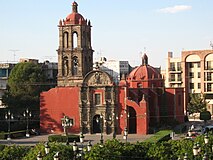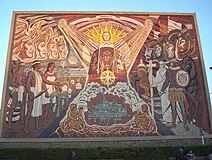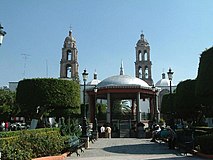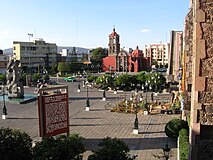Irapuato, Guanajuato
History
Prehispanic era
In the pre-Hispanic era, the site was inhabited by the Chichimecas (c. 1200 AD), a group of semi-nomadic hunter-gatherers. Later on, the Purépechas conquered the region and initiated the establishment of a permanent settlement. They constructed buildings in the Purépecha architectural style, produced pottery, and practiced agriculture. They called the settlement Xiriquitzio (or Iriquitzio), which the Spanish conquerors pronounced "Jiricuato" (or Jiricuicho), which meant "the place with houses (or low dwellings)". The initial growth period, however, was short-lived. The downfall of the Purépecha Empire led to the abandonment of the settlement, at which point it was once again inhabited by the Chichimecas.
Conquest
In the 16th century, vasts amounts of silver ore were discovered at the present day site of the capital city of Guanajuato. This discovery led to a massive migration of Spanish settlers to the area.
Flood
On 18 August 1973, thousands of homes were destroyed and an estimated 200 or 300 people killed when a dam burst, sending a seven-foot (2.1 m) high wall of water crashing into the city. Many people were left stranded on roofs and high places for days before they were rescued.
Massacres
Mass shootings occurred at drug rehabilitation centers on 6 June and 1 July 2020.
Geography
Climate
It has a humid subtropical climate (Cwa in the Köppen climate classification) with an average temperature of 20 °C (68 °F). The large majority of rainfall occurs from June - September. It is at an altitude above sea level of 1,724 meters (5,656 ft).
| Climate data for Irapuato | |||||||||||||
|---|---|---|---|---|---|---|---|---|---|---|---|---|---|
| Month | Jan | Feb | Mar | Apr | May | Jun | Jul | Aug | Sep | Oct | Nov | Dec | Year |
| Record high °C (°F) | 31.0 (87.8) |
35.0 (95.0) |
35.0 (95.0) |
38.0 (100.4) |
42.1 (107.8) |
38.0 (100.4) |
35.0 (95.0) |
32.0 (89.6) |
34.0 (93.2) |
33.5 (92.3) |
33.0 (91.4) |
32.0 (89.6) |
42.1 (107.8) |
| Mean daily maximum °C (°F) | 24.4 (75.9) |
26.3 (79.3) |
29.1 (84.4) |
31.1 (88.0) |
32.3 (90.1) |
30.2 (86.4) |
28.2 (82.8) |
28.0 (82.4) |
27.5 (81.5) |
27.1 (80.8) |
26.3 (79.3) |
24.9 (76.8) |
28.0 (82.4) |
| Daily mean °C (°F) | 15.2 (59.4) |
16.7 (62.1) |
19.4 (66.9) |
21.8 (71.2) |
23.7 (74.7) |
23.2 (73.8) |
21.6 (70.9) |
21.4 (70.5) |
20.9 (69.6) |
19.5 (67.1) |
17.5 (63.5) |
15.9 (60.6) |
19.7 (67.5) |
| Mean daily minimum °C (°F) | 6.0 (42.8) |
7.1 (44.8) |
9.6 (49.3) |
12.5 (54.5) |
15.1 (59.2) |
16.1 (61.0) |
15.1 (59.2) |
14.9 (58.8) |
14.3 (57.7) |
11.8 (53.2) |
8.7 (47.7) |
6.9 (44.4) |
11.5 (52.7) |
| Record low °C (°F) | −3.0 (26.6) |
−2.5 (27.5) |
0.0 (32.0) |
4.0 (39.2) |
5.0 (41.0) |
10.0 (50.0) |
6.5 (43.7) |
9.0 (48.2) |
4.8 (40.6) |
2.0 (35.6) |
0.0 (32.0) |
−2.0 (28.4) |
−3.0 (26.6) |
| Average precipitation mm (inches) | 11.5 (0.45) |
4.6 (0.18) |
3.8 (0.15) |
10.0 (0.39) |
30.5 (1.20) |
116.5 (4.59) |
164.3 (6.47) |
141.7 (5.58) |
105.9 (4.17) |
37.9 (1.49) |
9.6 (0.38) |
8.2 (0.32) |
644.5 (25.37) |
| Average precipitation days (≥ 0.1 mm) | 1.6 | 1.2 | 1.1 | 2.0 | 4.8 | 10.8 | 15.3 | 14.1 | 10.1 | 4.3 | 1.5 | 1.8 | 68.6 |
| Source: Servicio Meteorologico Nacional | |||||||||||||
Transportation
Airport
Irapuato is a 2 or 3 hour flight from cities including Los Angeles, Houston, Dallas, Mexico City, Monterrey, Guadalajara and Puerto Vallarta, among others. Located just 25 minutes from the city of Irapuato the Del Bajío International Airport (officially, Guanajuato International Airport) (IATA: BJX) is an international airport located in Silao, close to Irapuato, Guanajuato, Mexico. It handles national and international air traffic of the area that includes the cities of León, Irapuato, and the state capital, Guanajuato. Guanajuato International Airport is an important connecting point for some flights from Mexico City to the United States.
Major highways
Major highways in Irapuato and their starting and ending points:
 Mexican Federal Highway 45 Ciudad Juárez, Chihuahua - Panales, Hidalgo
Mexican Federal Highway 45 Ciudad Juárez, Chihuahua - Panales, Hidalgo Mexican Federal Highway 90 Irapuato, Guanajuato - Zapotlanejo, Jalisco
Mexican Federal Highway 90 Irapuato, Guanajuato - Zapotlanejo, Jalisco Mexican Federal Highway 43 Salamanca, Guanajuato - Morelia, Michoacán
Mexican Federal Highway 43 Salamanca, Guanajuato - Morelia, Michoacán Mexican Federal Highway 110 Armería, Colima - Xoconostle, Guanajuato
Mexican Federal Highway 110 Armería, Colima - Xoconostle, Guanajuato
Education
The city of Irapuato is home to some private universities including a branch of the University of the Incarnate Word, a Catholic university based in the United States, and a single public university, the Higher Technological Institute of Irapuato (ITESI).
The city is also home to a research center of the Center for Advanced Research and Studies (CINVESTAV) specializing in plant biotechnology and genetics and the newly created National Center of Plant Genomics.
Sport
The local football team is Irapuato FC, also known as La Trinca.
Stadiums and arenas
- Estadio Sergio Leon Chavez
- Plaza de Toros
- Parque Irekua
- Golf Club Santa Margarita
Notable people
- Amalia Macías – singer and actress who toured Europe
- Enrique del Moral – architect.
- Silvia Navarro – actress.
- Natalia Guerrero – actress.
- Carolina Miranda - actress.
- Carlos Cordero – athlete for Mexico at the 2012 London Olympics.
- Samuel Ruiz – Catholic prelate.
- Mario Castañeda – Mexican voice actor.
- Chucho Navarro – founding member of the Trio Los Panchos.
- Miguel Ángel Chico Herrera – president of PRI from 2005 to 2009.
- Roberto Alvarado – professional soccer player who plays for Cruz Azul in the Liga MX, and the Mexico National Team.
- Claudio González – professional soccer player who plays for Club Leon in the Liga MX.
- Óscar Razo – professional soccer player who played for Club Atlas in the Liga MX.
- Francisco Rotllán – professional soccer player who played for Mexico at the 1992 Summer Olympics in Barcelona.
- Sergio Ávila – professional soccer player who played for Chivas de Guadalajara and the Mexico U-23 national team.
- José Antonio Patlán – professional soccer player who played for Chivas de Guadalajara in 2006
- Juan Zaragoza – soccer player
Images
-
Mural depicting Miguel Hidalgo y Costilla and the Mexican Independence movement.
-
Hospitalito Church
-
Aguas Danzarinas Fountain
-
Irapuato's Hidalgo Garden
-
Templo de la Soledad
-
Plaza de Los Fundadores
-
Tercera Orden's Church, circa 1907. Photo courtesy SMU
Sister cities
 Aguascalientes, Aguascalientes, Mexico
Aguascalientes, Aguascalientes, Mexico Green Bay, Wisconsin, United States
Green Bay, Wisconsin, United States Houston, Texas, United States
Houston, Texas, United States Chula Vista, California, United States
Chula Vista, California, United States Laredo, Texas, United States
Laredo, Texas, United States Marianao, Havana, Cuba
Marianao, Havana, Cuba McAllen, Texas, United States
McAllen, Texas, United States Murcia, Murcia, Spain
Murcia, Murcia, Spain
References
- ^ "Historia de Irapuato". Enciclopedia de los Municipios de México. Archived from the original on 2012-03-20. Retrieved 2007-03-22.
- ^ Citypopulation.de Population of Irapuato municipality with localities
- ^ "2005 Census". INEGI: Instituto Nacional de Estadística, Geografía e Informática. Archived from the original on 2007-03-28. Retrieved 2007-03-22.
- ^ "Irapuato History". irapuato.gob.mx. Retrieved 2007-03-20.
- ^ "Historia de la Conquista". irapuato.gob.mx. Retrieved 2007-03-20.
- ^ 200 feared dead
- ^ 300 feared dead
- ^ "The killing of 26 people at a drug rehab center in Mexico thought to be part of a gang war". Los Angeles Times. 2020-07-03. Archived from the original on 2023-04-17.
- ^ NORMALES CLIMATOLÓGICAS 1971-2000 Archived 2010-11-08 at the Wayback Machine, National Meteorological Service of Mexico. Retrieved August 4, 2012 .
External links
- D IRAPUATO.COM SPANISH
- Presidencia Municipal de Irapuato Official website
- Irapuato Article on Wikipedia Español








